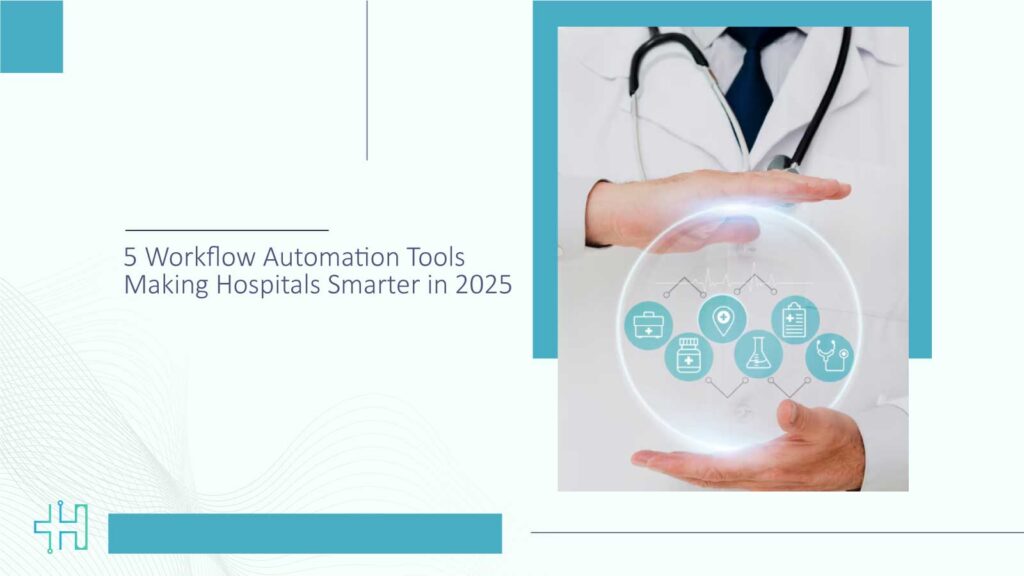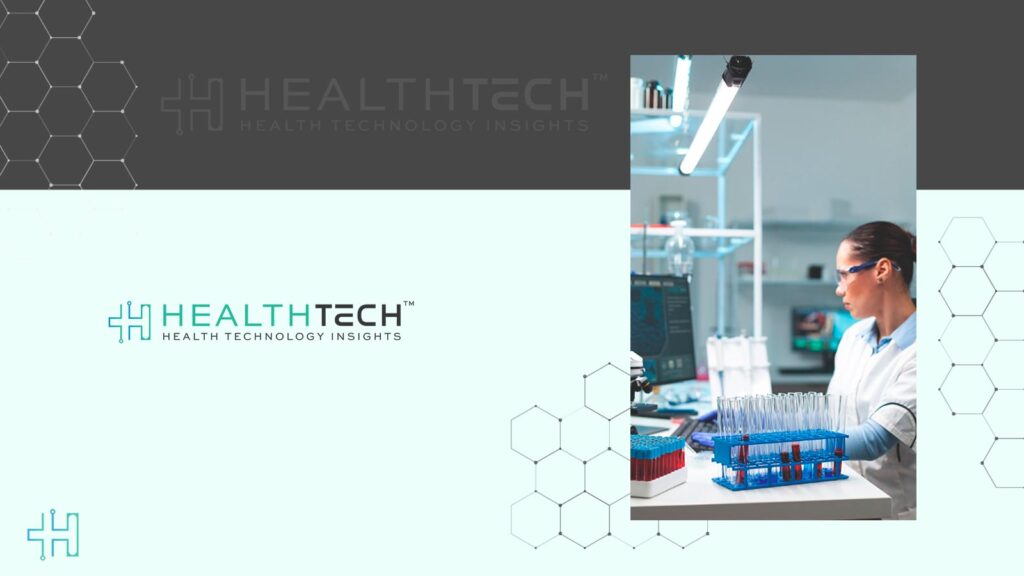Welcome to a glimpse into 5 workflow automation tools making hospitals smarter in 2025. Imagine walking into a hospital where routine tasks just happen, scheduling, documentation, and billing, all automated, letting clinicians focus on care.
In this article, you’ll learn how key tools are reshaping hospital operations with real examples, expert insights, and up‑to‑date research. Let’s explore how healthcare leaders and technology innovators in the U.S. and beyond are building smarter hospitals.
Why Automation Matters in Hospitals Today
Healthcare decision‑makers are prioritizing operational efficiency. Recent Deloitte research shows that over 70 % of C‑suite leaders view productivity gains and streamlined operations as top objectives in 2025.
Meanwhile, MGMA data reveals that AI tools, which underpin many automation platforms, are now the highest tech priority, surpassing EHR usability.
Workflow automation frees staff from repetitive tasks and helps avert fatigue. A survey by Feathery notes that automation can reduce processing times by up to 50 % and cut operational costs by 20–30 % in care settings. Hospitals adopting smart tools see faster patient throughput and fewer errors.
Top 5 Workflow Automation Tools Making Hospitals Smarter in 2025
1. Heidi Health – AI‑Powered Medical Scribe
Heidi Health’s AI scribe transcribes clinician‑patient conversations into formatted clinical notes, discharge summaries, and coded documentation. By integrating with EHR systems like Epic and Athenahealth, it automates clinical documentation and task generation, saving hours each day. In early 2025, it secured USD 16.6 million in Series A funding to scale globally.
2. Spikewell – Intelligent Ops & IT Workflow Automation
Spikewell deploys AI and automation to streamline hospital support workflows, IT ticketing, inventory lookup, and staff coordination. Deployed in U.S. health systems, it adapts to existing infrastructure without a full systems overhaul. Real‑time automation helps hospitals deliver care faster and smarter.
3. Microsoft Power Automate & Power Apps (Healthcare Edition)
Microsoft’s low‑code solution enables drag‑and‑drop workflow automation for scheduling, data tracking, insurance verification, and patient communications. It’s tightly integrated with Microsoft 365 and Azure, and it supports HIPAA‑compliant workflows with configurable templates.
4. FlowForma Healthcare Suite
FlowForma offers no‑code automation that accelerates hospital processes, from clinical trials and admissions to insurance claims and compliance workflows. Especially valuable in clinical trial management, its templates speed delivery while ensuring audit readiness.
5. Camunda (Enterprise Process Orchestration)
Used by large healthcare systems, Camunda models and runs complex, multi‑step care pathways, inter‑departmental handoffs, and decision rules. Camunda’s real‑time monitoring and analytical tools help leaders spot bottlenecks and fine‑tune workflows for patient safety and efficiency.
Real‑World Examples in Action
Let’s explore how leading healthcare systems are putting workflow automation into action and seeing meaningful impact, starting with a global name making big moves.
Apollo Hospitals (India)
Apollo has committed 3.5 % of its digital budget to AI automation tools. It aims to reduce doctors’ and nurses’ admin time by 2–3 hours daily, automating documentation, scheduling, antibiotic prescribing suggestions, and discharge summaries. Early pilots hint at major gains in staff time and clinician satisfaction.
Robotics and Automation in U.S. Hospitals
Tools like Moxi robots assist with tasks like medication delivery and inventory retrieval, freeing nurses to spend more time with patients. These systems reinforce the trend: automation tools are augmenting, not replacing, clinical teams.
What Makes These Tools Stand Out?
- AI‑Driven, Human‑Centric Automation
Platforms such as Heidi and Spikewell use generative AI and smart triggers to reduce manual entry while preserving clinician oversight. - No‑Code / Low‑Code Accessibility
Power Automate and FlowForma enable healthcare leaders to deploy automation without heavy IT support. - Compliance and Security Built‑In
These tools come with HIPAA‑compliant workflows, audit trails, role‑based access, and encryption. - Scalable and Integrated
Camunda and FlowForma integrate into existing EHR and admin systems, allowing stepwise transformation without disruption.
Predictions And Trends Shaping 2025
- The global clinical workflow automation market is poised to climb from around USD 13.6 billion in 2025 to USD 42.7 billion by 2034.
- Deloitte’s 2025 outlook confirms leaders are prioritizing scalable AI and automation investments to boost productivity.
More hospitals will adopt AI assistants, clinical scribes, and autonomous robots, thoughtfully guided by human oversight and ethics frameworks.
How Hospital Leaders Can Choose the Right Tools
- Map and prioritize workflows ripe for automation, e.g., admission, discharge, and billing.
- Pilot with a few tools, such as a medical scribe or scheduling bot.
- Ensure integrations with current EHR, HR, and billing systems.
- Engage staff early to build trust in automation’s benefits; human in the loop always matters.
- Monitor results, using tool analytics and feedback loops to refine deployments.
The Future of Healthcare Workflows Is Automated
By embracing these workflow automation tools, healthcare leaders can free up clinician time, lower administrative costs, and elevate patient experience. With tools like Heidi Health’s AI scribe, Spikewell’s operations intelligence, Microsoft’s Power Automate, FlowForma’s compliance workflows, and Camunda’s orchestration engine, hospitals are entering a smarter era.
As you plan your digital transformation for the year ahead, consider not just the technology, but how it supports people at the heart of care. The future of hospital workflow is smarter, more human, and more efficient than ever.
FAQs
1. What exactly does a medical‑scribe automation tool like Heidi Health do?
It listens to clinician–patient discussions and transcribes them into structured clinical notes, discharge summaries, task lists, and billing codes. It removes repetitive typing and lets clinicians focus more on the patient.
2. Can small hospitals use low‑code tools like Power Automate safely?
Yes. Power Automate and Power Apps are built to work with Microsoft environments. They include HIPAA‑compliant features, audit logs, and secure templates designed for healthcare operations.
3. How does Camunda differ from simple workflow tools?
Camunda handles multi‑step, highly interlinked workflows, for instance, a patient’s surgery admission, lab results, billing, and discharge flow. It offers detailed monitoring and analytics for end‑to‑end orchestration.
4. Do these tools replace staff or clinicians?
Not at all. Automation tools augment workflows; they relieve administrative load but leave clinical judgment entirely to humans, fostering trust and collaboration rather than replacement.
5. How soon can a hospital expect ROI from workflow automation?
It depends on the scope: documentation tools can yield time savings within weeks. Operational automations like scheduling or claims processing may take a few months to show measurable efficiency gains and cost reduction.
Dive deeper into the future of healthcare.
Keep reading on Health Technology Insights.
To participate in our interviews, please write to our HealthTech Media Room at sudipto@intentamplify.com



